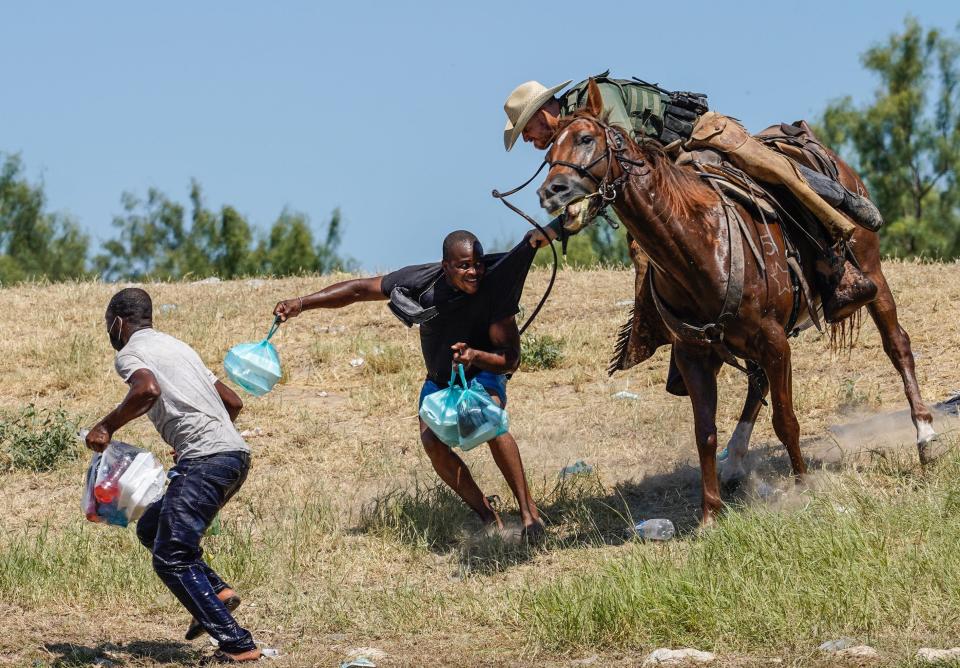Biden administration steps up drone program to monitor migrants heading toward border
WASHINGTON – The Biden administration is stepping up drone surveillance and communications with other countries to help prepare for migrant groups that could come to the United States’ southern border, just weeks after thousands of Haitian migrants unexpectedly arrived.
The administration was caught flat-footed by roughly 15,000 Haitian migrants who camped out last month under a bridge in Del Rio, Texas, with the White House itself calling images of mounted border agents chasing migrants "horrific." A record number of migrant children, families and adults, many of them from Central America, has come to the southern border this year, leaving the administration scrambling.
Homeland Security Secretary Alejandro Mayorkas told USA TODAY's Editorial Board and a group of reporters this month that the gathering in Del Rio was "most certainly a challenge that we had not encountered previously."
“And what we have done now is we have developed plans that should something like that occur again, we're ready for it," he said, without providing details.
What is the new program?
The Department of Homeland Security said in a statement Monday that it is using a combination of law enforcement and intelligence resources to help “operationally prepare” for large groups of migrants heading to the U.S.-Mexico border.
NBC News first reported on the new intelligence-gathering program.
The DHS will establish aerial surveillance of migrant camps and trucks as well as increase communication among the U.S. intelligence community and law enforcement agencies in other countries, NBC News reported.
The DHS’ Office of Intelligence and Analysis, U.S. Customs and Border Protection, U.S. Immigration and Customs Enforcement and the U.S. Coast Guard will be part of this new program, the DHS said in the statement. According to NBC, each of the agencies will supply personnel to the program and will monitor social media, such as Facebook and WhatsApp, on chatter about migration movements.
Officials are looking to work with countries like Colombia, Haiti, El Salvador, Honduras, Guatemala and Mexico as part of the program, NBC News reported.
More: Biden said he wanted to end the Trump-era 'Remain in Mexico' policy. So why is he restarting it?
“Gathering as much information as you can from various sources – open source to intelligence sources – helps you better prepare for what's coming soo that you can apportion resources accordingly,” said David Lapan, a retired Marine colonel and former DHS press secretary.
What does this program mean?
The Biden administration has had to reestablish its intelligence operations, experts say, and the new program is a part of that.
Gil Kerlikowske, who was commissioner of U.S. Customs and Border Protection under President Barack Obama, said the Trump administration often focused on politics rather than intelligence analysis. He said politicized rhetoric may make it difficult for officials to gather intelligence.
Though the DHS has used an interagency approach to help gather intelligence before, Lapan noted that the new initiative is putting a “finer point” in gathering information about where migrants are specifically coming from as well as what disinformation is being spread to those who want to migrate to the United States.
“Generally these things had been done in the past, but this seems to be putting more of a finer point on having a central capability and working more diligently to try to gather information before people move through Mexico,” he said. “It's one thing to gather information from various sources, but you have to put it all together in a way that it's actionable.”
More: Havana Syndrome is a mystery illness with 200-plus documented cases. Lawmakers are demanding action.
Lapan noted that by the time large migrant groups and caravans reach the border, the DHS is in “reactive mode.” But having an intelligence-gathering cell dedicated to monitoring possible migrant groups could help the DHS prepare, staff up and move resources to the right areas.
He added that the DHS could better combat disinformation that cartels and smugglers tell migrants who are considering making the dangerous and long journey to the United States.
“If you find out through intelligence means that smugglers, cartels are telling people a very specific thing that's untrue, then you can counter that directly,” he said. “That's the value of having that intelligence capabilities and information gathering.”
Biden's issues at the border
Thousands of Haitian migrants arrived at the U.S.-Mexico border last month, and the White House scrambled to address the crush.
About 15,000 Haitian migrants camped underneath a bridge in Del Rio, Texas, where there was limited food and water. When images of border agents on horseback chasing migrants went viral, White House Press Secretary Jen Psaki said, "Of course they should never be able to do it again," adding that it was "obviously horrific."

Within a week, the administration cleared the migrant camp. Many people were expelled or repatriated to Haiti.
Earlier this year, the Biden administration faced an increased number of unaccompanied migrant children at the U.S.-Mexico border. Images of Customs and Border Protection facilities that showed overcrowding and children sleeping on mattresses were released after advocates and lawmakers expressed concern about the conditions. The administration went on to establish additional facilities run by the Department of Health and Human Services to move children out of custody.
There has also been a record number of migrants coming to the border.
Biden has kept in place a Trump-era policy known as Title 42 that has allowed DHS officials to expel the majority of migrants coming to the southern border to avoid the spread of COVID-19.
President Joe Biden and the White House have repeatedly said the border is closed in an effort to deter migrants from coming.
Reach Rebecca Morin at Twitter @RebeccaMorin_
This article originally appeared on USA TODAY: DHS boosts drone monitoring of Central, South America migrants

